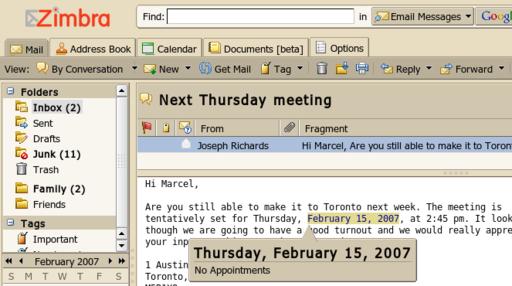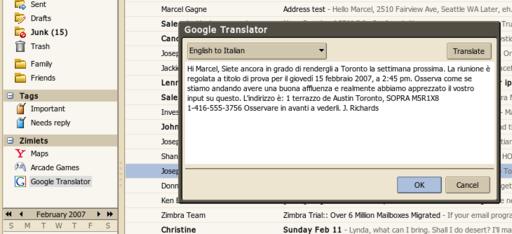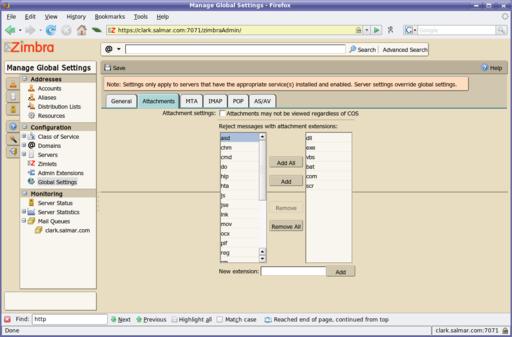
Zimbra exploits Ajax for a compelling Web groupware experience.
E-mail is the backbone of modern corporate communication, and frankly, it has been for a long time. As with any tool that gets this much use and features so prominently in any networked business, e-mail has demonstrated a host of limitations. To improve the experience, software developers have integrated certain obvious functions, such as calendaring, simple mailing lists and address books, thereby creating what is popularly referred to as a contact management system.
The great leap for enterprise contact management was the creation of groupware, or collaboration tools, allowing those calendars and contact lists to be shared among members of an organization. Administering complex packages on thousands of personal computer desktops creates its own set of problems though. As these increasingly complex systems grew, users noticed that they were now drowning in a sea of words, always trying to reach for that elusive piece of information that would help them stay afloat.
Zimbra's raison d'être is to improve the e-mail experience by providing a suite that simplifies as well as enhances the ease with which users can sort through and retrieve information.
The Zimbra Collaboration Suite (Figure 1) is a powerful, scalable application, suited for small to medium to very large enterprises. Zimbra can be deployed in a high-availability, clustered environment where it can serve up huge numbers of clients, and serve them it does. For instance, Zimbra customer H&R Block serves up 100,000 users, while the University of Toronto's numbers are in the tens of thousands. Zimbra's customers are varied (for example, Mozilla and Digg.com), from ISPs and content providers who offer Zimbra as a service to businesses, universities, government offices and nonprofits.
I've had a few weeks to play with the Zimbra Collaboration Suite, and I am, overall, very impressed. That said, nothing is perfect—more details as I go along.
The Zimbra Collaboration Suite belongs in a class of network applications we've come to call groupware—an intelligent collection of CRM, of which e-mail is the core, usually provided through a Web interface. In addition to e-mail, the Zimbra messaging server supports shared group calendars and contact management tools. Zimbra is both a client-side solution and a powerful integrated messaging server application that includes Postfix, LDAP, Apache and more. Zimbra includes some clever extensions, such as zimlets (more on these later), and enterprise mashups that allow users to interact naturally with information embedded in their e-mail messages, so they easily can use that information in other applications. These applications even can be third-party applications, such as a purchasing system.
It's impossible to talk about a product like Zimbra without making comparisons to Microsoft Exchange, so I answer the obvious questions here. Zimbra is an impressive replacement for Microsoft Exchange. Zimbra offers migration tools that simplify the move from Exchange to Zimbra (Lotus Notes migration tools also are available). Outlook clients are fully supported, and that means it works with all Outlook e-mail, contacts and calendar functions (MAPI sync, however, is available only with the Zimbra Network Edition). If you happen to be fond of another mail client, such as Thunderbird or Eudora, you can continue using it. That said, once you start working with Zimbra's impressive browser-based Ajax client, you may say goodbye forever to your old client software. Zimbra also supports a number of mobile devices, such as the iconic BlackBerry.
As the above paragraph hints, Zimbra is available in different flavors, including a community supported Open Source Edition and a commercially-supported Network Edition.
Zimbra is a Web application that doesn't feel like a Web application. Several very cool features take Ajax design to a very advanced destination. For instance, Zimbra provides natural keyboard mapping.
Let me give you an example. With most Web mail applications, you would delete a message (or a batch of messages) by selecting each message with a click in a check box beside the message, finding the Delete button and clicking there. Zimbra works the way you expect your desktop application to work. Simply select a group of messages (click, Shift-click, or Ctrl-click), and then press the Delete key.
Let me give you another example. In your run-of-the-mill Web mail application, you move messages into a folder by selecting them via a check box, clicking a “move to” button, clicking on the destination folder from a drop-down list, then clicking Move. Zimbra users select their messages and drag them into the appropriate folder—exactly like you would on your desktop. To switch folders, double-click on the folder. To read a message, double-click on the message. The key mapping is so natural that after a while, you forget you are working with a Web application.
This natural, or at least familiar, approach is consistent across all Zimbra applications. In the calendar view, creating an appointment is simply a matter of dragging your mouse across a time slot, and Zimbra pops up an appointment dialog for you to fill in (Figure 2).
When working with this sort of application, it's not unusual to check your e-mail, then switch to calendar view to confirm your free time, and then go back to your e-mail again. Zimbra can recognize strings inside your e-mail messages, such as a phone number or a date. Figure 3 shows me looking at an e-mail message in which the sender is asking whether I'm free for a particular date. Zimbra recognizes that this is a date and informs me of my availability for that time slot.

Figure 3. No need to switch from your e-mail to your calendar. Zimbra gives you the information you need, inline.
If the time slot is free, there's no need to switch to calendar view here either—simply right-click on the date, select New Appointment and then enter the details. It's wonderfully simple and intuitive.
It gets better. Zimbra also is able to recognize other contextual information (highlighted in blue), such as the word tomorrow, or even multiple words, such as next Wednesday. The program then checks your calendar for you when you hover over the word (or words). Zimbra also understands addresses and phone numbers, highlighting them as well. If it sees a phone number, Zimbra offers to launch a telephony program such as Skype or Ekiga. Hover over an e-mail address, and Zimbra looks up that contact in your address book and floats a pop-up with that person's contact information. No need to leave your e-mail and switch to your address book to call your client.
The user experience is enriched further with built-in antispam and antivirus tools, smart folders, RSS subscriptions and, of course, zimlets.
When you hover over a time in an e-mail message and a pop-up alerts you of your appointments for that time, you're seeing the work of a zimlet. A zimlet can launch Skype when you hover over a phone number. A few important zimlets are included in a default Zimbra installation, but there are several of which you might not immediately be aware, ranging from extremely useful to amusing distractions. When you install (or deploy) these extra zimlets, they appear in your sidebar, right above your mini-calendar.
Some of the extra zimlets are worth exploring. In addition to the phone dialer (which uses Skype by default), there's also a zimlet that takes advantage of an Asterisk VoIP system. Deploy the Yahoo! Maps zimlet, and Zimbra recognizes addresses embedded in text and pops up a street map when you hover over the address. This function didn't catch all address strings I tested, but you can enter the address manually by clicking on the zimlet. There's a Wikipedia zimlet and a Google translator zimlet as well (Figure 4). Simply drag a message onto the Google translator zimlet, select a language and click OK.

Figure 4. No cutting and pasting required for translations. Simply drag a message onto the Google Translator zimlet.
As much as I hate to admit it, the zimlet I wasted far too much time on is the arcade zimlet (call it a nostalgia trip). Several classic arcade games are included to provide some much-needed diversion. After all, all work and no play does not necessarily translate into increased productivity. Spend a few minutes blasting Asteroids, helping Frogger cross the street, saving the Earth from the evil Space Invaders or de-stress with a little game of Pac-Man (Figure 5).
There are also zimlets for traffic reports (letting your employees know when it's a good time to go home or what areas to avoid), and zimlets for Amazon.com sales, tracking flights, booking travel arrangements, looking up the status of an order or package, sending short messages (SMS) to a cell phone and more.
Zimlets can be installed manually (via the command line) or through the graphical Zimbra administrative interface, which I would recommend. The administrative interface is as well designed as the user interface but provides access to different functions. These include reporting and system statistics, user maintenance, global address lists, aliases, as well as server, site and domain configuration. Settings related to security are configured here as well. For instance, you may want to block out attachments with certain extensions, such as .BAT, .EXE, .VBS and so on (Figure 6).

Figure 6. The administrative interface lets you reject messages whose attachments have questionable extensions.
The administrative interface also provides download links to migration tools for Exchange and Lotus Domino servers. There's also a download there to help you import information from PST files.
Well, yes. Browser support could be a little better, but it covers the majority of browsers and certainly the most popular. I personally would like to see Konqueror supported and Opera as well. Some of the zimlets didn't always do what they were supposed to do—for example, the Yahoo! Maps zimlet sometimes highlighted addresses and sometimes didn't. Even there, I could double-click on the zimlet, enter the address manually, and it would come up.
The biggest negative, in my opinion, had to do with getting Zimbra up and running in the first place. The command-line text-install process feels a little last-century to me. Not that there's anything wrong with the command line—you're looking at one of the great proponents of the command line's power and flexibility. Nevertheless, having the installation shell script terminate to tell me I need another package, then having to restart it to discover I needed something else (then having it terminate again), is far from ideal.
Then comes the configuration part of the text install where parts of the dialog scroll off the screen. Sure, I can scroll back, but why not make it fit on a screen? Heck, a Web interface that assisted you in dealing with any prerequisite or configuration issues should be easy for a company that can come up with such a slick client interface.
I blame most of my installation problems on that inflexible text-only script. Before finding myself with a finished product, I ran three different installations. I tried the first install on my own production system, assuming (falsely) that I could run Zimbra concurrently—a bad move that took my own e-mail and Web services off-line for a few hours. To be fair, I can't really blame Zimbra here, because I should not have been doing that on a production system, but I often install and test software on my production systems without any problems. A simple warning that Zimbra's Postfix and Apache servers would occupy the same network space as mine (and that I might want to reconsider) would have stopped me in my tracks.
Eventually, I chose another clean system for my installation, and it just plain refused to finish. The generic error message told me nothing. Because it was a supported release, I tried again, re-installing (as opposed to upgrading), and everything worked perfectly. Why? This was the same system where it failed a few minutes before, so I don't have a good explanation.
When I finally got Zimbra installed, it was such a great experience I almost forgot about my installation headaches—almost.
Zimbra is a free and open-source package, but it also offers commercial packages and support. The Network Edition offers full commercial support plus additional, value-added features. For instance, clustering, including advanced backup and recovery features, and a powerful attachment search function, aren't part of the Open Source Edition. Neither are the Outlook MAPI and Apple iSync connectors; for these, you need the Network Edition. Over-the-air mobile synchronization (Simbian, Treo and Windows mobile phones with no additional software required on the handset) is another such value-add. Blackberry support is available through a third party. (Note to RIM—it would be really, really great if there were a general-purpose API for BEZ synchronization.)
The Zimbra Collaboration Suite is available for a variety of distributions and platforms. If packages for your particular distribution aren't available, Zimbra provides source so you can compile your own. Both Network and Open Source Editions are released at the same time. Zimbra doesn't want the installation to be different, regardless of whether it is the Network or Open Source Edition. Even so, only a few major distributions (such as Red Hat Enterprise Linux and SUSE Linux Enterprise Server) are supported for the Network Edition. If you are interested in the Network Edition, you may, for the time being, want to stick with the Open Source Edition.
If yours is one of the supported Network Edition platforms, I recommend that you download the Network Edition first. A free, 60-day trial is included, which provides you with all the Network Edition features. If you choose not to continue with the Network Edition after the 60-day period expires, your Zimbra Collaboration Suite automatically returns to the Open Source Edition, and you'll have lost nothing.
Prices for the Network Edition are reasonable, starting at $25 US per user, per year. Special discounted rates are available for educational institutions, governments and nonprofits.
Color me impressed! The Zimbra Collaboration Suite is a fantastic product and well worth your consideration. Working with Zimbra's polished Ajax client is a pleasure, and even the Open Source Edition is feature-rich. Some of the zimlets, though imperfect (such as the Yahoo! Maps zimlet), still provide a great improvement to the standard groupware experience.
Installation, on the other hand, could be a lot smoother, and I'd like to see more distributions supported in the Network Edition, but these installation-time issues don't affect the user experience.
If you don't need the features provided by the Network Edition, the price for Zimbra is certainly right, offering a great deal of functionality without the cost. If you want to take advantage of the Zimbra features but don't want to do the hosting on your own, Zimbra provides a list of hosting partners at www.zimbra.com/partners/zimbra_hosting.html. The main Zimbra site is www.zimbra.com.